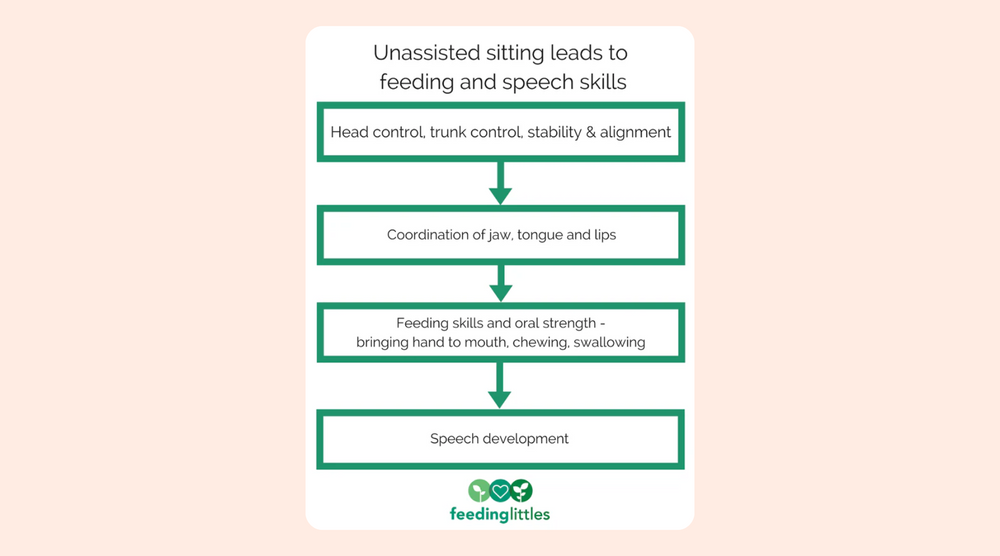
Sitting with minimal or no assistance is one of the most important readiness signs for feeding solids. For many babies, unassisted sitting happens around 6 months, which is also when current guidance recommends beginning complementary foods. (Note: this guideline refers to all “solids,” including finger foods and pureed foods or “baby food.”)
Why is sitting unassisted so important? First and foremost, we want your baby to be safe, and if they’re slouching or leaning while eating it can be more difficult for them to safely swallow food.
We also want babies to be successful while eating. Good postural support and control actually influence how our hands and mouths work – interesting, right? In other words, our bodies have to be in good alignment for our hands and mouth to work optimally.
Our co-founder Judy's first job as an Occupational Therapist was at La Rabida Children’s Hospital in Chicago, where she was fortunate enough to have Regi Boehme, OTR, as a regular mentor to their clinic. Regi was a gifted Occupational Therapist who created Boehme Workshops for Therapists (boehmeworkshops.com). Regi taught her that everything we ever need at the mouth (feeding, swallowing, and speech) originates from the hips. Judy co-authored this post in her memory for parents to better understand why sitting skills are an imperative precursor to feeding.
She always remembered Regi saying this phrase: “Stability at the hips will follow at the lips.”
Thus, for your baby’s best success at feeding, wait until your baby is sitting with minimal assistance on the floor before offering any food. Sitting propped in a Bumbo is not the same as unassisted sitting on the floor, and unfortunately use of these propping chairs actually doesn’t help develop sitting skills. (Read on for help teaching your baby to sit.)
OK, so we know sitting is important before introducing solid foods. But…how can I help my baby learn to sit?
Let’s back up for just a moment. Sitting is actually just one piece of the overall developmental puzzle, and all the pieces fit together to help your baby eat, move, learn and talk. To understand how babies learn to sit, we have to understand the other steps to get there.
Below are some common milestone guidelines for the first half of infancy. Remember, all babies develop at their own pace, so your baby may not be on this exact timeline. Discuss any developmental concerns you may have with your pediatrician.
Gross- and Fine-Motor Skill Developmental Milestones:
1-2 months:
- Displays jerky hand movements
- Hands are fisted and may bring one hand to mouth
- Lifts head while on tummy briefly
- Moves head side to side while on tummy
- Brings hands to midline while on their back
3-4 months:
- Able to pick up their head while lying on stomach
- Stretch out legs and kick them while on their back
- Grasps with palm and shakes toys
- Holds up head in supported sitting
- Can open hands and bring them to the midline of the body
- Clasps hands and starts to can grasp toys on purpose
5-6 months:
- Can move their head from side to side while sitting
- Sits by leaning on hands
- Beginning to weight bear thru their legs
- Opens hands more and straightens out fingers
- Reaches for and grasps objects
- Can drop a toy and pick it up
- Likes to bang objects on tables, repeatedly (fun, right?)
- Begins transferring objects from hand to hand
- Can hold their own bottle
- May begin to push up to all fours from tummy
- May begin to rock back and forth on hands and knees
- Lunges forward and reaches while in a sitting position without losing balance
Think about development of your baby in these terms:
Head control, trunk control, stability and alignment are all essential for motor control and coordination of the jaw, tongue and lips. In other words, for the mouth to work effectively, your baby’s body must have stability, alignment and control. This coordination allows baby to learn to feed themselves, and strengthening of these muscles and reflexes eventually leads to speech development!
Another way to think about it: development is a “delicate balance between stability and mobility” (Morris 1987). All the pieces falling into place allows your baby to become a walking, talking, self-feeding child barring any developmental or medical issues.

So, when you’re preparing your child for food, it is essential that they are learning to sit!
How can I help my baby learn to sit?
Just like every other skill, practice is key! Practice sitting on a carpet or soft flooring multiple times a day as early as 4 months, or when you baby has good head control.
- Sit your baby between your legs while seated in a "V" position on the floor. Conversely, you can put a Boppy or breastfeeding pillow behind your baby's back. You can place your hands around baby's hips or torso to give them extra support.
- As your baby gets used to this position, place a rolled-up towel or soft large block between their legs to give them something to put their hands on. This is called "assisted sitting," as they are using their hands to help hold their body up.
- Keep practicing on the floor frequently! You can put a Boppy or other breastfeeding pillow around their back in case they fall. Never leave your baby alone while they practice sitting, as they are likely to tip over until they get much stronger.
How long does my baby need to sit on the floor to be sitting “well enough” for solids?
Your baby shouldn’t immediately topple over when placed on the floor., but there’s no true guideline for how long they need to sit before offering solids. Just try putting them on the floor and watch if they can stay upright for a bit. If they immediately topple over, they’re probably not ready yet. Ensure that your baby doesn’t lean in the high chair or doesn’t seem floppy or uncoordinated.
How do I know if my baby is in a good position in their high chair?
Briefly check your baby’s posture and stability the first time you put them in a high chair. How do they look? We talk all about this in our high chair post if you want more guidance!
What if my child seems unsteady or uncomfortable in a high chair, even though they can sit on the floor unassisted?
Sometimes your baby can sit well on the floor, but over time they start to lean in their high chair. This may be the result of a very big chair without much support, including the lack of a footrest. You may notice that your baby seems uneven, floppy or uncoordinated, even though he can sit on the floor for a while without fatiguing.
To remedy this:
- Add some additional support like a rolled up towel, flat pillow or chair insert behind your baby’s back.
- Use rolled up towels or receiving blankets on either side of your baby if they tend to lean.
- Add a foot rest to your baby’s feet if their legs are long enough to hang over the edge. This is important for toddlers as well! If needed, use a box of tissues duct taped to a stable surface as a foot rest. Once your baby has strong footing, it’s easier for him to them up straight and with control in a high chair.
We talk a lot more about high chair stability and footrests in our high chair post.
If my baby is showing readiness signs for food, including sitting well before 6 months, should I give them food?
This one is up to you! For some families, starting earlier works…just keep in mind it can be easier to wait until 6 months. After all, you'll be feeding your baby from now until forever...there's no need to jump the gun unless you have to!
We recommend starting “around 6 months” and when your baby is showing readiness signs, including sitting well, bringing their hands to their mouth and showing interest in food.
Some families need to offer solids earlier than 6 months as advised by their provider for growth or nutritional needs.
What if my baby isn’t sitting unassisted by 6 months?
Keep working on it! Sometimes babies just need more practice. Include plenty of tummy time in your baby’s day, and work on sitting multiple times a day. Don’t forget to make it fun! Your baby will pick up on your stress.
If baby isn’t sitting by 7 months, talk to your doctor. Additionally, if your baby has any developmental delays or medical issues, talk to your therapy team about safety and readiness signs for solids. We don’t want to wait too long for solids, as we miss an important allergenic, digestive, and developmental window, but every baby will be different with this.
So remember…when you get your baby’s hips aligned, their lips (and mouth and tongue) will be more ready for food!
